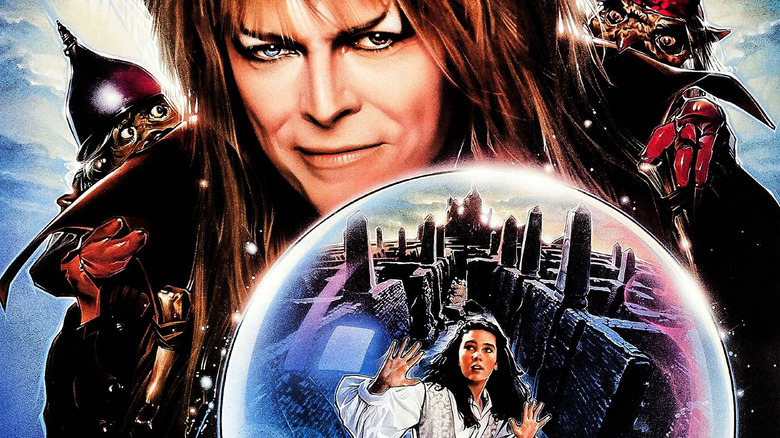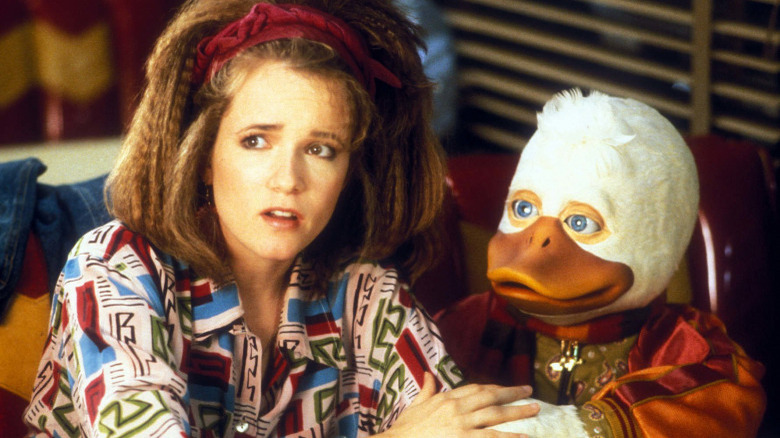Why Darth Vader Was Behind The Scenes During The Filming Of Labyrinth
When he wasn't voicing Kermit the Frog and other members of the beloved Muppet gang, Jim Henson often made dark, weird fantasy movies like "The Dark Crystal" (which he co-directed) and 1990's "The Witches" (which he produced). As a kid who loved dark, weird fantasy movies, his non-Muppet work was firmly in my wheelhouse when I was growing up, in the same way that his Muppet films and the original "Star Wars" movie trilogy were. Yet, it wasn't until I was older that I became aware that "Star Wars" creator George Lucas played a key creative role in developing what was probably Henson's strangest creation in a career full of them: 1986's "Labyrinth."
One of only two films that Henson directed alone (the other being 1981's "The Great Muppet Caper"), "Labyrinth" bombed at the box office upon its release, barely grossing half of its $25 million budget in the United States. Critics praised Henson and his collaborators for the sheer amount of imagination and hard work they poured into realizing the film's universe of bizarre fantasy creatures, yet felt the movie just didn't work as a whole. As Roger Ebert wrote in his own review, "Some real thought went into it and the David Bowie soundtrack is fine, yet there's something missing. It never really comes alive."
While Lucas is only credited for being an executive producer on "Labyrinth," he was also one of several writers who made contributions to its shooting script during production (with Terry Jones ultimately receiving sole credit for the movie's screenplay). As that implies, he played a very hands-on role on the film's development and, by all accounts, was very supportive of Henson's efforts to realize his eccentric vision. On the first day of shooting (via Mental Floss), Lucas even showed up with an actor dressed as Darth Vader and had them give Henson a card wishing him good luck.
Turns Out, George Lucas Is an Odd Duck
The idea of Lucas working on "Labyrinth" makes a lot more sense when you look at his output as a writer-producer in the years between the release of "Return of the Jedi" in 1983 and his return to directing with "The Phantom Menace" in 1999 (the "Indiana Jones" franchise aside). Henson's gnarly, horny, musical fantasy romp might be a far cry from Lucas' classic space operas, but it wasn't all that different from 1986's "Howard the Duck." Let it not be forgotten that the notorious Lucas-produced comic book movie features, among other "Only in the '80s" moments, the mom from "Back to the Future" (aka the multi-talented Lea Thompson) almost having sex with an anthropomorphic alien duck.
1988's "Willow," which Lucas produced and wrote the story for, wasn't bereft of crude humor either. Still, it otherwise marked a return to the more conventional fantasy storytelling that characterized Lucas' work on "Star Wars" after the oddities that were "Labyrinth" and "Howard the Duck." Six years later, though, audience would get another unfiltered taste of Lucas' zaniness with 1994's "Radioland Murders" (which he once again produced and wrote the story for). Of course, odds are you've never heard of Lucas' ode to 1930s screwball comedies and whodunnits, given how badly it performed across the board.
Unlike that movie, however, "Labyrinth" has gained newfound appreciation over time, much of it coming from people who, like me, saw the film at a young age and latched onto its curious mix of family friendly puppet antics and sexualized visuals. More recently, the tale of Sarah Williams and Jareth the goblin king has even come to be regarded as a fascinating parable about a teen girl's coming of sexual age (and no, I'm not just talking about Bowie's infamous bulge as Jareth, though there is that). Such is the peculiar, intertwined legacy of Jim Henson and George Lucas.

